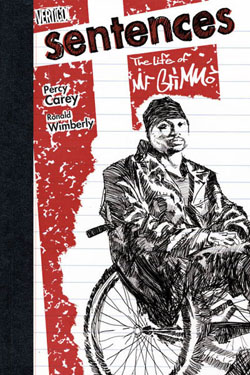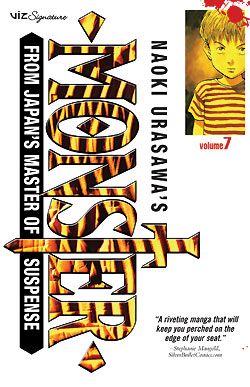
The new comics rack at The Beguiling. Photo courtesy Photosapience
The problem with disagreeing with Brian Hibbs’ column, “Tilting At Windmills,” is that it always feels a little like telling a business owner “hey, you don’t know how to run your business” when really, you just have different ideas about the nature of how businesses are run.
For example, in Hibbs’ last column, he talks about how single issue comics (and specifically longer storylines which are serialised over any number of single issues before being collected in trade paperback), are necessary for comic shop owners…. not so much for their bottom line as for their cash flow. Here’s Brian talking about it:
In the micro, the periodical comic book provides a tremendous amount of cash flow to both publisher and retailer. Book publishing tends to be “burstâ€-y – weeks will pass where nothing especially significant gets published, then half a dozen major books will all drop at once. Without the (relatively) steady week-in, week-out publication of serialized comics, your friendly neighborhood comics store will never be able to keep their doors open.
At Comix Experience, over half of our sales come from book-format material (as opposed to comics-format), but I’d have to shut tomorrow without the steady, and reliable cash-flow that the periodical provides. Periodicals provide cash-flow, books provide the profit.
This totally rubbed me the wrong way. Hibbs is right, of course, in saying that without periodicals “your friendly neighborhood comics store” would close their doors. This is because their operations, their business plan, all of it is rooted in this system of periodical comics serialisation and release. If everything that eventually would get released in trade paperback was instead only released in trade paperback starting tomorrow, yeah, the whole system would collapse.
But if you took the percentages Hibbs puts forth in his piece, ‘more than half’ of his gross coming in from book-format titles, and told him to try and operate under similar conditions 10 years ago, he’d have a similar system collapse. His observation that periodicals provide cash-flow is, while accurate, also irrelevant, because it’s far from the only method of generating cash-flow as a retailer and I don’t personally believe it’s the most effective in a market that is increasingly moving away from periodical production. It’s simply “how things are done because that’s how we’ve always done them” and if there’s one thing I’m tired of seeing in comics, it’s that. I’m not arguing that it’s not useful to have these comics for cashflow purposes, but again, it’s not the only way.
Particularly when the customers are telling you, in increasing numbers, that those comics aren’t what they want.

If the complaint is that Vertigo in particular have trained customers to wait for the trade, then developing systems to punish readers who do so is not the answer. Actually, that sounds a lot like you actually don’t like your customers very much, which… again. I’m not telling you how to run your business, we just disagree that making it harder or more annoying for people to buy things in my store serves me in the long run. Mr. Hibbs, if Vertigo can’t launch a series these days because their audience is either entirely divided or has massively switched to a different format preference, then Vertigo needs to follow the money, so to speak, and start publishing the way that their customers want. Their original graphic novel program has been doing fairly well as of late, so far as I can tell and so far as I’ve heard, with good word-of-mouth and press for SENTENCES, PRIDE, FABLES 1001 NIGHTS, and lots of buzz surrounding upcoming titles. If something like Crossing Midnight or American Virgin can’t catch on sales-wise in single issue format, which leads to poor sales on the collection, ‘enh’. Hibbs makes the argument that Crossing Midnight in particular is a good book, “as high in quality as Fables”, but Crossing Midnight was a book with an exceptionally, painfully slow start that crippled sales in our store. I’m glad that the series has (apparently) found its creative feet, but the most common compliment about the book that I’ve heard is that “it really took until issue 4 for the premise to become clear and for it to get good”. That’s four months, including a heavily-promoted first issue, for readers to encounter the series, not enjoy it, and either spread the word (negatively) or just skip it all-together. “I tried it, didn’t like it. On to something else.” If that book were an OGN and came together in the last third and then ended on a great, positive note? Great! A new series of books that we can sell! One that hadn’t been poisoned by consumer apathy after 4 months of mediocre comics!
 Hibbs’ other argument is the cost of moving to trade paperback-only releases; are consumers going to try out a new title that will run them $20 instead of $3? They didn’t mind doing it for Pride of Baghdad, which may have been a fluke, but let’s look at Sentences: The Life of M.F. Grimm. It launches at 1,700 copies, which ranked it number 63 on the top 100 graphic novels for that month. Retailers are notoriously cheap about ordering OGNs, particularly hard covers, but those numbers aren’t bad. Particularly when, at $20 a pop, that’s the equivilent of sales of about 11,400 copies at three bucks a pop, placing it alongside DMZ and 100 BULLETS rather than American Virgin… Also, has a black lead character, which is usually sales death in the male/white/hetero-centric direct market. Actually, hah, if the MF GRIMM hardcover had its sales translated to the single-issue charts, it would be the top-selling book with a black lead character for the month. Sentences isn’t just a success for a Vertigo Original Graphic Novel, it’s a TRIUMPH for the comics industry.
Hibbs’ other argument is the cost of moving to trade paperback-only releases; are consumers going to try out a new title that will run them $20 instead of $3? They didn’t mind doing it for Pride of Baghdad, which may have been a fluke, but let’s look at Sentences: The Life of M.F. Grimm. It launches at 1,700 copies, which ranked it number 63 on the top 100 graphic novels for that month. Retailers are notoriously cheap about ordering OGNs, particularly hard covers, but those numbers aren’t bad. Particularly when, at $20 a pop, that’s the equivilent of sales of about 11,400 copies at three bucks a pop, placing it alongside DMZ and 100 BULLETS rather than American Virgin… Also, has a black lead character, which is usually sales death in the male/white/hetero-centric direct market. Actually, hah, if the MF GRIMM hardcover had its sales translated to the single-issue charts, it would be the top-selling book with a black lead character for the month. Sentences isn’t just a success for a Vertigo Original Graphic Novel, it’s a TRIUMPH for the comics industry.
Okay, seriously, 1705 sales is pretty mediocre through the direct-market, but it’s still better than a 10th of the top-seller of the month, The Walking Dead Volume 7, which moved around 13k during the month, and which shows you that these aren’t vast gulfs of numbers we’re talking about here, like the 150,000 copies and 8,000 copies that mark the top and bottom of the top 300. Speaking of the best-selling graphic novel of the month, although it wasn’t listed as part of Hibbs’ thesis (being as it isn’t a Vertigo book) TWD sells about 23k in serialization and that 13k in collection, which (while not at par) is pretty interesting. It’s another one where the collection comes out directly on the heels of the serialisation, quicker than any Vertigo collection, and usually following a much more eratic serialisation schedule. And yet? It totally works, there are distinct audiences for both formats… The series gets stronger and stronger in collection, with new readers funneled into the collections stream, and yet there are a ton of readers who still find the single issues incredibly compelling. Why is this, do you think? Maybe it’s because EACH ISSUE IS INCREDIBLY COMPELLING. I don’t even care if you think it’s “good” or not, but you can’t argue that ending each issue on a “literally anything can happen” cliff-hanger makes for a compelling read. This is a characteristic that it shares with the successful titles in Vertigo’s line; Fables, Y The Last Man, 100 Bullets, DMZ, these are titles with compelling larger narratives as well as individual issue-to-issue reads that reward the reader for coming back every month (the exact opposite of wanting to punish the reader who only wants to come back every 6 months…). Maybe the problem with series like American Virgin (recently cancelled) or Un-Men (unspectacular launch) is that through both execution and concept, they just aren’t grabbing people! You can argue that Army @ Love is as high-quality as Fables all you want, but Vertigo’s had a long, successful history with fairytales and fantasy that enabled it work to find an audience for that series. They’ve got no history at making something like Army @ Love work… hell, I’m actually not sure who the audience for that series is other than “Vertigo readers” and “Fans of Rick Veitch”, who’re both lovely groups of people, but quite a bit smaller as a prospective audience than Fables’ “Fantasy/Fairy Tale Readers” and “Fans of Neil Gaiman” demographics.
Also: Quality doesn’t mean fuck all when it comes to sales. They cancelled The Invisibles twice for low sales, and that’s better than anything Vertigo is publishing these days by a good solid measure.
 Getting to my eventual point: Vertigo is training readers to wait for the trade: Fantastic! I don’t know why they’ve decided to take the financial hit to do so, but someone needed to do it to clear out some of the clutter of single issues that dominates the Previews catalog. There’s between 20 and 40 book-format comics being released to the direct market every week, at $10-$50 a pop. It’s nice when we get to build an audience for something over a couple of issues, but it’s just as nice to build an audience for something like NAOKI URASAWA’S MONSTER by selling them the first $10 trade, and then having them be hooked on a series of $10 evergreen books, rather than $3 periodicals with a 30 day shelf life. We’re not hurting for product to sell outside of the single-issue format, I don’t think any other forward-looking retailer is facing that problem either…
Getting to my eventual point: Vertigo is training readers to wait for the trade: Fantastic! I don’t know why they’ve decided to take the financial hit to do so, but someone needed to do it to clear out some of the clutter of single issues that dominates the Previews catalog. There’s between 20 and 40 book-format comics being released to the direct market every week, at $10-$50 a pop. It’s nice when we get to build an audience for something over a couple of issues, but it’s just as nice to build an audience for something like NAOKI URASAWA’S MONSTER by selling them the first $10 trade, and then having them be hooked on a series of $10 evergreen books, rather than $3 periodicals with a 30 day shelf life. We’re not hurting for product to sell outside of the single-issue format, I don’t think any other forward-looking retailer is facing that problem either…
If the readership is seriously moving towards collections on the Vertigo titles, lets support that and get behind it sales-wise rather than trying to do anything to cripple it. Follow the money, not the past.
Oh, and I outright don’t-buy the argument that readers won’t sample a new IP (intellectual property) when it’s $20 rather than $3… They do it in every popular medium including dvds, cds, video games, movies, oh and BOOKS, like from bookstores. Between internet previews, magazine previews, advance reader copies, POP material and more, there’s plenty of ways to get the customer interested in your project well before it arrives in stores, and rather than instituting an earnings-cap at Vertigo by telling them how infrequently they’re allowed to publish trade paperbacks, I’d rather they used any money they’re making by pumping two FABLES trades out a year (thanks, DC/Vertigo!) to print up previews and promotion for their OGN program, like that preview the published of the forthcoming CAIRO Original Graphic Novel (that generated quite a bit of advance interest in the book for us…). Sounds like a better use of everyone’s money to me.
My two cents.
– Chris
Sorry for the delay, I’ve been sick.


I enjoyed your essay (and this entire debate), but I’m really bad at comic-book math: Sentences was an 128 page book, which is roughly, what, 5-6 issues of a comic. So, the trade sold the equivalent of 11,400 copies of a single issue, but isn’t that only 1900-2280 copies on a theoretical per issue basis? That sounds awful. At least for DC Vertigo? Did I do the math wrong?
1) I was using dollah-bills, not pages. Sentences is 20 bucks, and I compared it to the chart based on that, not on page-count.
2) That’s what makes the whole enterprise such a ridiculous bullshit-fest. Hibbs made all of his comparissions on one set of data favourable to his position, pure sales numbers regardless of things like retail cost/printing cost/dollahs made. I pointed out a difference of opinion based on another dataset favourable to my own opinion. I like hearing the sound of my own voice as much as the next guy, but I’m not usually doing so to agitate for change that’s going to affect the bottom-lines of my retailing cohorts, you know?
Anyway, thanks for the compliment. I don’t know how but I had no idea you had a blog. Off to read it now.
Interesting content analysis of recent Vertigo books. I think you slightly mischaracterize Brian’s argument, though: unless I missed the point, he was mainly arguing with Vertigo’s timing regarding putting out trades of single issues — he thinks they’re coming too fast. I don’t really agree with that — I think the books should be examined case-by-case — but it’s a slightly different argument.
I’ve argued the ogn question on Heidi’s site, so I won’t get into it here. Suffice it to say that DC/Marvel page rates are a significant factor in this decision. And even if you’re only selling 10,000 copies in single issues, why give that up when, historically, patterns show that you won’t sell a single copy less — and quite possibly more — when you do publish the collection?
One correction: You may be speaking in hyperbole, but “They cancelled The Invisibles twice for low sales” is just wrong. Sales were flagging a bit, so Grant suggested the v2 relaunch, which followed within a few months of the end of v1. The series had always been structured as three “books,” so relaunching v3 as a new #1 then followed from the first decision.
“If the complaint is that Vertigo in particular have trained customers to wait for the trade, then developing systems to punish readers who do so is not the answer. Actually, that sounds a lot like you actually don’t like your customers very much”
AGREED! Seems like a recipe to alienate the last few true believers.
This same debate/issue is going on with indivual DVDs versus box sets of TV Shows.
Stuart- Thanks for jumping in. RE: Mis-characterising Brian’s argument, I don’t think so. I think I adressed the meat of it but I also have problems with his methodology and his thinking, how he arrived at that argument. I find it flawed.
Your OGN discussion really does rely on Marvel/DC Page rates for serialisation to become necessary. Coming up out of art-comics it’s a totally different story. If you read a few of the interviews with Adrian Tomine, following the release of his new book SHORTCOMINGS you’ll run across a quote something to the effect of “I think my publisher only puts out single issues of my work as a favor to me,” because you look around and you see that the artcomix single issue is a rare thing, these days, most work going straight to collection. Adrian is actually one of the few creators whose work turns a profit in serialisation, actually, and even as a means of amortising the eventual book collection, single issues became unprofitable for a number of publishers a long time ago. With numbers at Vertigo dropping into the 7,000s, that ‘fuck the floppies’ number has gotta be getting pretty close.
That’s an interesting characterisation of The Invisibles! I had only ever heard low sales/reprieve from cancellation as the reason for relaunches. Thanks.
– Christopher
Well, the Vertigo books selling 7,000 copies aren’t moving big numbers in trades, either. There are exceptions — mostly titles whose writers have book-market cachet. But they’re pretty rare. Most books are either hot or they’re not.
Yeah, I disagree with the meat of Brian’s argument too, though I totally understand where he’s coming from. I said this way down on Heidi’s board, but I really think this is one of the rare areas where (certain) retailers’ interests don’t coincide with readers’.
Regarding INVISIBLES: I only edited volume 1, but I recall that the v2 relaunch — which, again, was wholly Grant’s idea — raised numbers a bit, mostly because of the presence of Phil Jimenez as regular artist (ably followed by Chris Weston). I don’t think the book was in any danger after that.
Stuart- If the single issue sales and the trade paperback sales are two different audiences–this isn’t a given–then doesn’t it stand to reason that the sales of one format do effect (canibalize) the other? Maybe Testament is doing mediocre business in singles and in trades, with 10% of the audience buying both formats, but what if you added the trade sales to the single-issue sales (less 10%)? It’s still not gangbusters, but doesn’t that get closer to ‘viable’? And again, not on every author, but Douglas Rushkoff isn’t every author… It’s not hard to see how a graphic novel-oriented publishing format would have benefitted him (also: clarity).
I don’t mean to sound unempathic to Brian’s retail concerns either, it’s no surprise that in retail circles this column was _very_ appreciated because it feeds into commonly-held beliefs about the comics industry, and SOP. But while this is an argument about how retailers’ and readers’ interests don’t coincide, I would (and have, I think) further argue that what Brian is arguing for really isn’t even in his OWN best interests, long term.
If his argument ends up being that it’s in Vertigo’s best interests to prop up flagging single-issue sales unnaturally… Well I just don’t know what to say about that one.
Thanks for the perspective Chris.
I have to say that as a customer, I took umbrage with the TAW column because it was critical about Vertigo’s trade program, which I think has become the most customer friendly program in the industry. I’ll happily pick up the first trade of any Vergito series and the nice $10 introductory price, especially after having read the first issue online at DC’s website (for free). I means nothing to me whether I get it 2 months or 6 months after the last issue of the storyline comes out, but I won’t be essentially blackmailed into buying the floppies just because there might not be a trade if the floppies don’t sell.
I think it really comes down to trying to get customers to buy the same material more than once, something that Marvel seems to put a lot more effort into that DC. It strikes me personally that someone is much more likely to buy something twice if it is offered in a more deluxe format, i.e. floppy buyers might be more inclined to pick up a hardcover over a trade.
Also, I think it’s a bit disingenuous to compare first month trade sales to floppy sales, especially for likely perennial sellers in the Vertigo vein. I imagine that Fables v1, which charts in the top 100 almost every month, has sold twice as many copies as the floppy average in the DM alone.
Chris: Well, yes, I do think the sales from one format cannibalize the other to some extent. That’s why FABLES sells less, in single issues, than (say) the Ennis/Dillon HELLBLAZER did, fifteen years ago. There wasn’t a reliable trade program back then, so if you wanted the books, you had to buy the singles. That’s a reasonable tradeoff for a publisher like Vertigo, though, because of all the obvious advantages of trades: continuing sales, bookstore placement, etc.
But I’m not convinced that dropping the serialization of most of these books would increase sales of the trades, or ogns, or whatever. It’s arguable that the single issues act as cheap tasters for the trades, for people who don’t buy every issue as it comes out. Singles certainly get reviewed more, and help immensely with word of mouth.
Obviously there’s no way to prove any of this, because there’s no control for the experiments — every book and every author are different. And Vertigo is a funny animal in a lot of ways…
Chris: here’s a response for ya’, where I’m just talking about the issue I perceive, and not getting bogged down in specific examples:
http://savagecritic.com/2007/11/responding-to-titling-responses.html
I might be back a little later today with some point-by-point stuff
-B
Like X says, “…it doesn’t have to the be way it is, you say it is, just ’cause for the past 20 year every day it is…”
Personally, I haven’t bought a floppy for the last four years or so… I used to back when it was unsure whether things would get collected at all (mostly DC or Image books… Marvel has been pretty much collecting everything and anything in one format or another reliably and without exception for awhile). I can’t really say how this affects my ability to enjoy a book IE versus reading it serialized, but I do like the format better, find it takes up a lot less space, and is easier to organize on my shelf or in my filing cabinets.
As to trying out a few series in TPB or GN format… I do so pretty much every week with manga, and have with mainstream books as well (IE: The EXCELLENT Hernadez collections, which, if I’d tried them in floppy format, I probably wouldn’t have been interested in at all). I actually have to say that I find it easier to know if I’ll like something if I have a bigger chunk of the story than can be found in 32 pages (if I’m going to commit to the long run, rather than just that particular storyarc).
Anyways, that’s just my perspective as a customer… nothing scientific or anything. I just prefer the format and how it reads, and I’d rather spend $10-20 on something to find out if I’ll like it rather than spending $3 over the course of 4-6 monthes to find out if it’ll pan out, and get stuck with floppies I can’t get rid of, because there’s a TPB out. :B
It seems to me that the problem is twofold: Singles are less risky for retailer but a horrible deal for consumers. Trades are a great deal for consumers but a huge risk for retailers. Delaying or canceling trades would certainly make singles more attractive to consumers but it’s not really a progressive solution. It’d just piss people off. I think it’d be better to either make singles a better deal for consumers (by either lowering the price or increasing the content) or to make trades a better deal for retailers by instituting returnability. Or both, which would be awesome.
I’m all for publishers making the singles more attractive to readers… I don’t think it should surprise anyone that if publishers don’t treat single issues as any more than the next 22 pages in their graphic novel that the customers won’t either. Either through making the story incredibly compelling, the addition of letter columns, back-matter, back-up stories, etc.
Or, you get advertising in TV Guide and through a psychotically devoted fan community with Buffy, and then who cares? Bang those 22 pages out!
More Fell, less Faker.
– Chris
I really enjoyed your thoughts, Chris. But I have a few questions:
1) If all comic companies moved away from monthly books, would the Direct Stores stay open? Yes, people seem to buy their collected or graphic novel books at comic stores, but they can find most of those same books at Barnes & Noble or Borders. The reason I would guess that they choose to buy the books at a Direct Market store is that they are also there to get their monthly books. Wouldn’t the comic industries decision to get rid of monthly books turn Direct Market stores into mom & pop bookstores which will quickly run out of business?
2) Also, what about comic creators? Without the monthly books, you wouldn’t have many of your TPB’s that you have. The system is set up for creators to put out books monthly so they have a steady stream of income to keep working. To produce a 100+ page graphic novel takes a lot more time than a 22-page monthly book. Many creators are not in a place financially to take the time to complete a 100+ page book.
Or… maybe moving to non-monthly books would help weed out weaker creators… who knows?